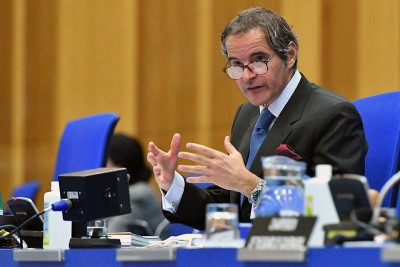IAEA Expresses Concern About Zaporizhzya Nuclear Power Plant in Ukraine
The situation at the Zaporizhzhya Nuclear Power Plant (ZNPP) in the Russian-occupied zone of Ukraine is increasingly worrying, according to recent reports. In order to avoid an accident that could endanger the health of the Ukrainian and other public, Rafael Mariano Grossi, Director General of the International Atomic Energy Agency (IAEA), has advised the utmost caution.
 Director General of the (IAEA), Rafael Mariano Grossi, is very concerned about the current developments. / Picture: © IAEA International Atomic Energy Agency / Dean Calma / Flickr Attribution (CC BY 2.0, https://creativecommons.org/licenses/by/2.0/)
Director General of the (IAEA), Rafael Mariano Grossi, is very concerned about the current developments. / Picture: © IAEA International Atomic Energy Agency / Dean Calma / Flickr Attribution (CC BY 2.0, https://creativecommons.org/licenses/by/2.0/)
Recent reports on the Zaporizhzhya Nuclear Power Plant (ZNPP) indicate an increasingly worrying situation at the plant in the Russian-occupied zone in Ukraine. Now the Director General of the International Atomic Energy Agency (IAEA), Rafael Mariano Grossi urged the utmost restraint to avoid an accident that could endanger public health in Ukraine and elsewhere.
Already in June, Grossi expressed concern and reiterated the urgent need to send an expert mission to the Ukrainian nuclear power plant to get the confusing situation under control and take appropriate action. Vindobona reported.
Now that no opportunity has yet been offered by the Russian occupants of the area around the Zaporizhzhya nuclear power plant to send an IAEA expert mission, Mariano Grossi addressed the public again: "These reports are very worrying and underline the importance of the IAEA visiting the Zaporizhzhya nuclear power plant. I am continuing my determined efforts to arrange and lead a safety and monitoring mission to the site as soon as possible. It is urgent."
A number of reports, both in the media and in the form of official communications to the IAEA, suggest that the already difficult and stressful conditions for Ukrainian staff at the plant have deteriorated further.
Director General Grossi has already pointed this out several times. In addition, there have been reports in recent days pointing to further potential threats to the safety of the plant.
Recent reports about the #Zaporizhzya Nuclear Power Plant indicate an increasingly alarming situation there and @RafaelMGrossi has called for maximum restraint to avoid any accident that could threaten public health in #Ukraine and elsewhere. https://t.co/bGYN7qAK8F pic.twitter.com/FoKLcg03rQ
— IAEA - International Atomic Energy Agency (@iaeaorg) July 22, 2022
In order to analyse these circumstances and warn of potential dangers, the IAEA has been pressing for a visit to the nuclear power plant in recent weeks. So far without success.
The IAEA has not been able to visit the Russian-occupied plant in southern Ukraine since the conflict began five months ago. It is therefore unable to confirm or deny the reports about the country's largest nuclear power plant with six reactors.
"However, we take them very seriously. Since the beginning of the military conflict in Ukraine, the IAEA has warned of the risk of a major nuclear accident in a country with 15 reactors in four operating NPPs. In light of recent unconfirmed reports of incidents at or near the Zaporizhzhya NPP, I am very concerned about this very real danger with potentially serious consequences," said Director General Grossi.
"It is extremely important that no action is taken that could in any way compromise the safety of this plant, which is also the largest in Europe. In a conflict of this kind, a nuclear facility can be damaged unintentionally. This must be avoided at all costs," Grossi added.
Director General Grossi has repeatedly stressed that the IAEA must be able to send a mission to the Zaporizhzhya nuclear power plant to carry out essential safety and security measures at the facility.
As an independent and impartial organisation, the IAEA's presence would also be crucial for a better understanding of the situation at the NPP, which has been controlled by Russian forces since 4 March but continues to be operated by Ukrainian personnel, he said.
As for safeguards, the IAEA continues to receive remote monitoring data from the four operating NPPs, but is still experiencing a partial breakdown in the transmission of monitoring data from Chernobyl, the Director General said.
Ukraine separately informed the IAEA today that ten of the country's 15 nuclear power reactors are currently online, including three at the ZNPP nuclear power plant, three at the Rivne nuclear power plant, two at the South Ukraine nuclear power plant and two at the Khmelnytskyy nuclear power plant.
The other reactors were shut down for regular maintenance. According to Ukraine, the safety systems at the four NPPs are still operational and they continue to have an external power supply.



